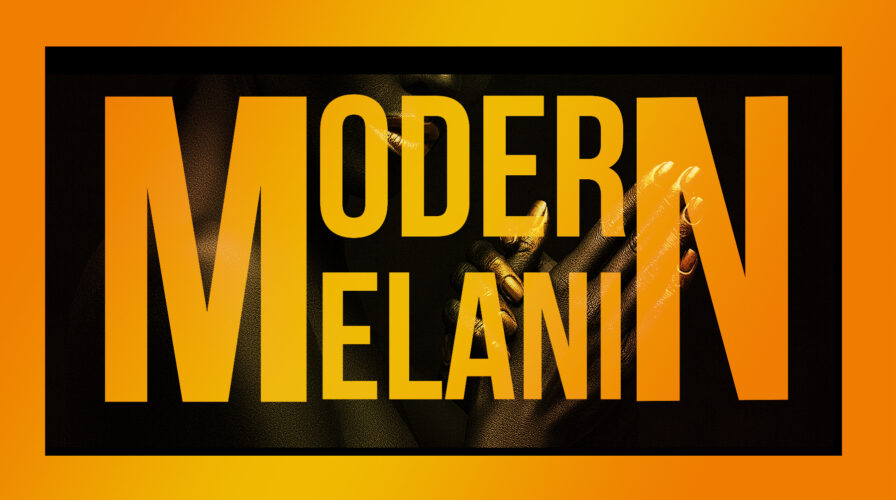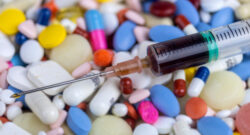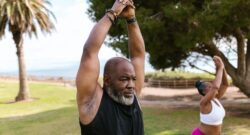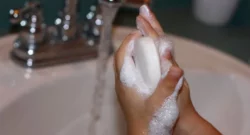Author: admin
Vaccines and Population Control?
By Supreme Understanding The Bill and Melinda Gates Foundation recently hosted a presentation on how ultrasonic frequencies could be used to sterilize men from a distance. Yes, you read that right. I can only imagine how they would use that…and who they’d use that against. Doesn’t sound like something “good guy” Bill Gates would be into? You have no idea. In addition to this sterilization program (which would use sharp blasts of ultrasound directed against a man’s scrotum to render him infertile as a sort of “temporary castration”), the foundation also funded a new “sweat-triggered vaccine delivery” program based on “nanoparticles that penetrate the skin through hair follicles and burst upon contact with human sweat to release vaccines.” According to Gates, he’s raising money to develop vaccine programs “designed to protect children in developing countries from various diseases, including tetanus.” But the Gates tetanus program bears striking resemblance to another tetanus program that sterilized thousands of women and caused abortions in many others in the Philippines. (As reported by the BBC in conjunction with the Philippine Department of Health and the Philippine Medical Association, women in child-bearing years were given a vaccine that was combined with a chemical known as Human Chorionic Gonadotropin (HCG), an anti-pregnancy agent.). But why sterilize people? At a February 2010 TED conference, Gates talked about reducing CO2 emissions worldwide, by limiting population growth. He said: The world today has 6.8 billion people. That’s headed up to about nine billion. Now if we do a really great job on new vaccines, health care, reproductive health services, we could lower that by perhaps 10 or 15 percent! This “population elimination” idea may sound similar to the “conspiracy theories” about the spread of HIV in Africa (which led Nobel Peace Prize laureate and environmental activist Wangari Maathai to charge that “AIDS is a biological weapon manufactured by the developed world to wipe out the Black race” although he later denied such sentiments), but the connections between the spread of smallpox vaccines and HIV in Africa were just one of many cases where Western vaccines (or other medicine) brought hidden problems with them. As recently as 2004, pharmaceutical scientist Dr. Haruna Kaita was contracted by an Islamic body to check out polio vaccines being administered by the WHO in Nigeria. After extensive and repeated tests carried out using state-of-the-art facilities in India, a shocked Dr. Kaita reported that the vaccines were laced with contaminants, some toxic and some having “direct effect on human reproductive system.” But why sterilize people in poor countries? Sterilization, eugenics, and population control all go hand-in-hand. It’s all about controlling who is here in 100 years. And it’s been going on for quite some time. In 1798, Thomas Malthus published An Essay on the Principle of Population, describing his theory on how population growth will exceed earthly resources to provide food for all people. We now know that there is certainly enough food (and land) on the planet to feed everyone, and that hunger is a result of poverty and other forms of social inequity, not simply “too many people.” In fact, many European nations have 10 times more people than your average African nation with twice the land. Also, when you factor in the amount of resources it takes (fossil fuels, land, water, etc.) to feed people on a meat-heavy over-indulgent Western diet, that’s very different from what the rest of the world needs to survive. Soon after the US State Department published the Global 2000 Report for the President in 1980 advising that the world population must be reduced by 2 billion people by the year 2000, Thomas Ferguson of the State Department Office of Population Affairs, Latin American Desk, elaborated: There is a single theme behind all our work – we must reduce population levels. Either governments do it our way, through nice clean methods, or they will get the kinds of mess that we have in El Salvador, or in Iran or in Beirut. Population is a political problem. Once population is out of control, it requires authoritarian government, even fascism, to reduce it…Our program in El Salvador didn’t work. The infrastructure was not there to support it. There were just too goddamned many people…To really reduce population, quickly, you have to pull all the males into the fighting and you have to kill significant numbers of fertile age females…The quickest way to reduce population is through famine, like in Africa, or through disease like the Black Death. Does this put everything in perspective for you? Does it help you understand why Gates would fund something like the programs above? Does it change the way you see all those wonderful agencies doing “healthcare” in developing countries? (Not all, of course, because there are many smaller groups that have good intentions) Does it make you think about what similar agencies are doing (and have already done) with the Black and brown communities of THIS country? Does it make you take a fresh look at why they push birth control and abortion so hard in the hood, while putting fertility clinics and sperm banks in white neighborhoods? Does it make you wonder what this rush to “stop global warming” is really about, since they’re trying to “save the planet” while getting rid of most of the people on it? As we’ll explain in depth in Chemical Genocide, this new wave of environmentalism is NOT centered on the interests of Original people. In fact, most of its strongest advocates are all FOR wiping YOU off the planet. Here are a few more quotes to think about: “Malthus has been vindicated, reality is finally catching up with Malthus. The Third World is overpopulated, it’s an economic mess, and there’s no way they could get out of it with this fast-growing population. Our philosophy is: back to the village.” – Dr. Arne Schiotz, World Wildlife Fund Director of Conservation, 1984 “The biggest problems are the damn national sectors of these developing countries. These countries think that they have the right to develop their resources as they see fit. They want to become powers.” – Thomas Lovejoy, vice president, World Wildlife Fund U.S.A., 1984 “If we look at things causally, the bigger problem in the world is population. We must set a ceiling to human numbers. All development aid should be made dependent on the existence of strong family planning programs.” – Sir Peter Scott, chairman, World Wildlife Fund U.K., 1984 I used to get mad about those commercials pushing the plight of the polar bear, and after seeing the quotes above, I understand why. There’s more: “It will be impossible to feel that the world is in a satisfactory state until there is a certain degree of equality, and a certain acquiescence everywhere in the power of the World Government, and this will not be possible until the poorer nations of the world have become…more or less stationary in population…If there is not to be an endless succession of wars…this will probably have to be done, in many countries, as a result of governmental measures. This will require an extension of scientific technique into very intimate matters.” – Bertrand Russell, The Impact of Science on Society, 1952 “What would it take to accelerate fertility decline in the least developed countries?” – March 2009 U.N. Population Division policy brief “Frankly, I had thought that at the time Roe was decided, there was concern about population growth and particularly growth in populations that we don’t want to have too many of.” – U.S. Supreme Court Justice Ruth Bader Ginsburg “It now remains for the U.S. government to set a sensible example to the world by offering a bonus or yearly pension to all obviously unfit parents who allow themselves to be sterilized by harmless and scientific means. In this way the moron and the diseased would have no posterity to inherit their unhappy condition. The number of the feeble-minded would decrease and a heavy burden would be lifted from the shoulders of the fit.” – Margaret Sanger, Founder of Planned Parenthood, 1926 “All children who are born, beyond what would be required to keep up the population to a desired level, must necessarily perish…Therefore…we should facilitate…the operations of nature in producing this mortality; and if we dread the too frequent visitation of the horrid form of famine, we should sedulously encourage the other forms of destruction, which we compel nature to use. Instead of recommending cleanliness to the poor, we should encourage contrary habits. In our towns we should make the streets narrower, crowd more people into the houses, and court the return of the plague. In the country, we should build our villages near stagnant pools, and particularly encourage settlement in all marshy and unwholesome situations. But above all we should reprobate specific remedies for ravaging diseases; and restrain those benevolent, but much mistaken men, who have thought they are doing a service to mankind by protecting schemes for the total extirpation of particular disorders.” –Malthus, An Essay on the Principle of Population, 1798 And one more, in case you’re unclear as to whom these undesirable people are: “The white population of the world will soon cease to increase. The Asiatic races will be longer, and the negroes still longer, before their birth rate falls sufficiently to make their numbers stable without help of war and pestilence. Until that happens, the benefits aimed at by socialism can only be partially realized, and the less prolific (child-bearing) races will have to defend themselves by methods which are disgusting even if they are necessary.” – Bertrand Russell, The Impact of Science on Society, 1952 Be less trusting of what organizations, corporations, and even some doctors about what you should put in your body. What Can I Do About All This? You may have never heard of it, but the President’s Cancer Panel, which reports directly to the president – just released a new report on these chemical toxins we’ve been describing in this chapter. The landmark report[1] evaluates current scientific evidence and the positions of over 40 experts, and concludes that public health officials have “grossly underestimated” the role environmental contaminants may be playing in the 1.5 million Americans who are diagnosed with cancer each year. The report called for stricter regulations on chemicals and safer alternatives, especially noting that these toxins are most dangerous to young children and unborn babies. In this government-issued report, they actually admit that today’s babies are “pre-polluted” with over 300 different chemical contaminants found in the umbilical cord blood of newborn babies! Let me repeat: These were not weirdoes and conspiracy theorists. These are mainstream, highly-respected scientists (the head of the panel is a Black man!) saying this. I hope that’s not what you needed to hear to take us seriously, but if you did, there you go. So what do you do? Here are the President’s Cancer Panel’s recommendations (from pages 145-147 of the report) for what you can do to protect yourself and your family. Choose foods, house and garden products, play spaces, toys, medical tests, and medicines that will minimize your kids’ exposure to toxic chemicals. (This means eating organic as much as possible and buying products that you know to be free of BPA, phthalates and other endocrine disruptors.) Eat meat produced without antibiotics and added growth hormones. Avoid or minimize consumption of processed, charred, and well-done meats to reduce exposure to carcinogenic heterocyclic amines and polyaromatic hydrocarbons. If you’re pregnant or thinking about it: Both mothers and fathers should avoid exposure to endocrine-disrupting chemicals and known or suspected carcinogens prior to a child’s conception and throughout pregnancy and early life, when risk of damage is greatest. Take off your shoes when you enter your home, especially if you work with or around chemicals. (Wash work clothes separately from other laundry.) Filter your tap water. And continue to choose tap water over commercially bottled water. (See, “BPA Can Make You A New Man.”) Store food and water in containers made from stainless steel, glass, or BPA- and phthalate-free plastic. Don’t microwave in plastic, since chemicals can leach into food when it’s heated. (See, “Plastic Poisons.”) Stop using chemical fertilizers and pesticides on your garden to keep these chemicals from contaminating drinking water supplies. Properly dispose of medications, household chemicals, paints and other materials to minimize drinking water and soil contamination. Turn off lights and electrical devices when not in use to reduce your exposure to petroleum combustion by-products. Drive a fuel-efficient car, bike or walk when possible, or use public transportation to cut the amount of toxic auto exhaust in the air. Wear a headset when you use your cell phone, keep calls brief, and text instead of calling when possible to reduce your exposure to electromagnetic energy. Have your home’s radon levels tested periodically. Avoid second-hand smoke. (And don’t smoke yourself. Duh.) Talk to your doctor about the need for tests or procedures that involve radiation exposure and keep a record of all imaging or nuclear medicine tests received and if known, the estimated radiation dose for each test. Wear sunscreen and UV-protective clothing. (See “Skin Cancer is NOT Prejudiced”) Tell your Congressperson to support the Safe Chemicals Act of 2010, which would overhaul the riddled-with-loopholes Toxic Substances Control Act of 1976. Organize and educate people in your community about what’s happening. Add many of these steps to your daily routine. Convince the people in your household of how important this is. [1] http://deainfo.nci.nih.gov/advisory/pcp/pcp08-09rpt/PCP_Report_08-09_508.pdf
Pop Quiz: Are You Healthy?
Before we jump into the content of this book, we’ve gotta be clear that this process won’t work if you’re not being honest with yourself – in terms of where you’re at and where you need to be. But even the most honest of people don’t necessarily know how “healthy” or “unhealthy” they are, because there’s so much to that whole health thing. So we’re gonna help you learn about yourself. Try the following quiz and see how you score. What have you got to lose? It’s not like somebody’s gonna see your score and laugh cause you’re unhealthy. Unless you and your friends have this same book. Then, they might. Or you might get to laugh at them. Either way, it’s cool because laughter is the best medicine. See, you’re already on your first step to healing! Seriously though, knowledge is half the battle. The other half (more like 7/9ths) is putting in the work once you have the knowledge. You gotta start somewhere, start with this quiz! 1. Do you eat fried foods? a. Less than twice a week. b. Occasionally, but I’m mindful of it. c. Pretty regularly. d. If it ain’t fried, I probably don’t want it. 2. How long would it take you to walk a mile? a. Less than 10 minutes. b. Between 10 and 20 minutes. c. I’d have to take a few breaks, so I’m not sure. d. Why would I walk a mile? 3. When seated with my legs straight in front, I can bend forward at the waist and reach… a. Past my toes. b. Near my toes. c. My shins. d. My knees. 4. I can balance on one foot, extend my arms, and stand still… a. More than 3 minutes. b. 1 or 2 minutes. c. About 30 seconds. d. I’m not even gonna try that and embarrass myself. 5. Do you drink sugary sodas and artificially flavored “juices”? a. Never. It’s real fruit juice, tea, or water for me. b. Rarely. I go for days without having any sugary drinks. c. Sometimes. But I can manage a day without any. d. Often. It would be hard for me to go without them. 6. Do you exercise? a. I could be an athlete or a personal trainer (30 to 60 minutes most days) b. I’m in decent shape, but I’m not ready for the marathon. (About 30 to 45 minutes a few times per week) c. I can help you move out of your apartment, but not by myself! (About 30 minutes twice a week) d. Sometimes I have to walk across a big parking lot. (Very little, if ever) 7. Do you eat sweets or candy? a. What’s a snickerdoodle? (Never) b. Where’s the snickerdoodles? (Rarely) c. I need some snickerdoodles. (Sometimes) d. I am the snickerdoodle. (Often) 8. Do you eat red meat? a. Never. b. Not often. c. At least once or twice a week (or “I eat beef but not pork”) d. They call me “Swinefeld” 9. Do you have breakfast in the morning? a. Yes, daily. And it’s usually pretty healthy. b. Most days. And it’s usually pretty healthy. c. Most days. But it’s usually not that healthy. d. Does a cup of coffee count? 10. Do you smoke? a. No, and I never have. b. I used to smoke, but I quit. c. I don’t smoke, but I live with or work around smokers who puff near me. d. All day. Nicorette ain’t got a patch strong enough for me. 11. When was the last time you had your blood pressure and cholesterol checked? a. Within the past year. b. Within the past two years. c. Several years ago. d. I can’t remember. 12. How much sleep do you get at night? a. 6 or 7 hours a night. b. 8 or more hours a night. c. Less than 6 hours a night. d. My sleep patterns are so irregular I couldn’t even tell you. 13. Do you use any “recreational” drugs? a. Nope. I get high off my success. b. I might smoke a little weed on occasion, but that’s it. c. I might do a little bit more than weed. d. I could be considered a junkie, if you were trying to be mean. 14. How is your dental health? a. My dentist worships me. b. I haven’t seen the dentist in a while, but I brush and floss regularly and I don’t have cavities. c. I don’t brush or floss like I should, and I probably have a few cavities I need to address. d. I’m probably gonna lose some of these teeth. 15. How much sunlight do you get? a. If I was white, I’d have an awesome tan. b. I get at least an hour of sunlight daily. c. I’m stuck indoors most weekdays, but I try to make up for it by getting some sun on the weekends. d. I’m practically a vampire. I can remember the last time I spent a while in the sun. 16. How much water do you drink? a. All I drink is water (More than 64 ounces). b. 8 glasses a day, like the doctor say (48-64 ounces). c. I don’t drink as much as I should (16-48 ounces). d. There are too many other things that taste better (0-16 ounces). 17. How do you deal with illnesses? a. I know how to cure most things naturally and who to see when I don’t. b. I consult with a healthcare professional and develop a regimen that will combat the illness. c. I see a doctor and hope he knows how to fix me. d. I pop some pills, say a prayer, and hope for the best. 18. What kind of medicines do you take? a. Mostly herbs, minerals, and whatever else Mother Nature provides. b. Mostly natural stuff, but I use the synthetic stuff too. c. Mostly the synthetic chemical stuff, but I’ve been trying natural remedies too. d. Mostly pills, needles, and whatever else Medicaid provides. 19. Do you have mood swings or rapid emotional changes? a. No way. That’s crazy as hell. b. It’s rare, but it happens. c. More than I’d like to admit. d. All day. I’m crazy as hell. 20. When is the last time you fasted or did a cleanse? a. Within the past month. b. Within the past six months. c. Within the past year. d. The only detox I know about is the one you do for a urine test. 21. How often do you get headaches? a. Rarely. b. Sometimes, but I usually know what caused it. c. Often, and they can get bad. d. I got one right now, and I’ll probably have another one soon. 22. How often do you eat fresh or steamed vegetables? a. At every meal b. At most meals c. Not often…does rice and peas count? d. Um…do the tomatoes in ketchup count? 23. When was the last time you had your stuff inspected? (Pap smear, STD test, breast exam, testicular exam, prostate exam) a. Within the past two years. b. Three or four years ago. c. Five or more years ago. d. I ain’t doin none of that nasty stuff. 24. How often do you treat pains with an over-the-counter pain reliever? a. I take one once or twice a year, or I used a natural remedy. b. I use them occasionally. c. I pop a pain reliever most days. d. Over the counter? Please. Gimme that Vicodin baby. 25. How much alcohol do you drink? a. I average one drink or fewer per day. b. I drink once in a while, but then I’ll often have four or more. c. I have about two drinks daily. d. I average more than two drinks a day; at times I can’t remember how much I drank or what I did afterward. 26. What do you eat more of, pastries or fruit? a. All fruit, no pastries or sweets. b. More fruit than pastries and sweets. c. More pastries than fruit. d. Mostly pastries and sweets, almost no fruit. 27. What’s your waist size? a. Less than my hips b. Bout the same as my hips c. A little more than my hips d. C’mon son! I’m FAT. 28. Do you have a family history of heart disease, diabetes, cancer, or other hereditary illnesses? a. No parents or grandparents with any problems like that. b. 1 or 2 of my parents or grandparents have 1 or 2 problems like that. c. Most of us got something. d. Everybody’s got something, and some of us got everything. (or “I have no idea”) 29. Which best describes your sexual practices? 30. I’m in a long-term, mutually monogamous relationship. a. I’m not committed to one person; but I always use condoms when I have sex. b. I’m not committed to one person; and I don’t always use a condom. c. I get it in, by any means necessary. 31. How do you typically cope with stress? a. I regularly carve out time to recharge. b. I vent about my crises to a friend or a family member. c. I don’t know what to do. Usually I just feel overwhelmed. d. I depend on alcohol, food or another vice to help me make it through the day. 32. I experience fatigue… a. Only after a strenuous workout or similar physical activity (ahem). b. Usually after a long day of work c. After climbing a set of stairs, taking a long walk, or carrying something heavy d. Pretty much throughout the day, even when I haven’t done anything 33. I experience back or muscle pain… a. Never. b. Sometimes. c. Pretty often. d. I stay with some kind of pain. 34. When I stand against the wall… a. The back of my head, hips, feet, and shoulder blades touch the wall. b. Only the back of my hips, feet and shoulder blades touch the wall. I have to change my posture for my head to touch the wall. c. Only the back of my hips and feet touch the wall. I have to change my posture for my shoulder blades to touch the wall. d. Only the back of my hips touches the wall. I don’t want to talk about it Scoring Scoring Key Items Marked Points A: 0 points Number of As: ____ x 0 = ____ 0 B: 1 point Number of Bs: ____ x 1 = ____ C: 2 points Number of Cs: ____ x 2 = ____ D: 3 points Number of Ds: ____ x 3 = ____ TOTAL SCORE = Scoring Ranges and Explanation 0-10: OPTIMUM You’re either insanely healthy or just plain insane. Most people are nowhere near this level of optimum health, so we congratulate you (if you’re telling the truth). If you lied, you may need to skip ahead and go straight to the section on psychological health, because that’s just strange. Assuming that you were being truthful, you’re a living example of the principles in this book. Because of how much information we’ve packed into the following pages, we’re sure you’ll still learn a lot. But you’ll find this text most valuable if you use it as a teaching tool for the people you know who need it more than you. 11-25: EXCELLENT A great score. You should be proud. You eat healthy, live healthy and probably even think healthy. Sure, there are some things you could work on, but with this book, you’re definitely on the right track to optimum health and a long, satisfying life. 26-50: DECENT Even with a score in this range, you’re still doing better than most Americans. But if you think about it, that’s not necessarily a high standard to measure yourself against. Perhaps you need to eat more fruits and vegetables and less junk. Perhaps you should be exercising more and spend less time indoors. Perhaps you should go see a doctor or a dentist soon. Whatever the case, you have plenty of room for improvement, and this book will make sure you cover it all. 51-75: UNHEALTHY Don’t be offended at being called “unhealthy.” We’re just being real with you. You knew you weren’t too healthy when you took this quiz, so don’t be mad at us for telling you what you already know. The question now is ‘What am I going to do about it?’ You can either continue on the downward spiral of unhealthy living, cut several years off your life, and finally end up dead before your time or sick and miserable in your old age…OR you can get on the upward spiral to better living. It’s your choice. You have family members who chose not to address their health until it was too late. You’ve seen what happens. It’s going to be some work, but this book will guide XE “Tips” you through many of those changes, showing you both the big steps and the baby steps you can take. Aren’t you tired of feeling the way you do? Make a decision. Your bad habits can still be changed! 76-90: SICK You’ve got a LOT of unhealthy habits. You know you do. You’ve been treating your body like a rental car you don’t plan on returning. But it’s all gonna get billed to you in the end. You pay for all those habits, one day, some way. And it’s never pretty. In your present condition, you’re probably already sick. You may have diabetes, cancer, arthritis, heart disease…who knows? You may not even know what you have. But unless you’re going to kill yourself now, you should consider this 91-100: DEAD Seriously? How do you even get a score in this range? I know crackheads who would score higher. Either you were trying to be funny when you took this quiz, or you’re an unhealthy crackhead. You can’t even get 100 points on this quiz. It’s mathematically impossible. Just like it’s almost physically impossible to live much longer with the type of lifestyle you have, if you scored in this range. If you really scored between 91 and 99, this book could literally save your life. The first step is knowing you can improve. Then you apply solutions.
I’ll Be Your Pusher: The FDA
“If people let government decide what foods they eat and what medicines they take, their bodies will soon be in as sorry a state as are the souls of those who live under tyranny.” – Thomas Jefferson Everyone who is concerned with their health should get familiar with the Food and Drug Administration, or the FDA. This is a federally run organization which was created to protect citizens from the adverse effects of pharmaceutical drugs, food, tobacco, vaccines and even veterinary products, amongst other things. However, these days it seems that the FDA has gone from being our protector, to a drug pusher and peddler. The regulation of products, drugs, and food can be a good thing. However, when government-run programs, which are there to serve us, become the pushers for wealthy drug companies, this is bound to take a toll on our collective health, well-being, and lifestyle. Most people in the general public tend to believe that if they see an FDA approval symbol on the product that they’re buying, they’re safe. But, what does it really mean to have a product approved by the FDA, versus a product that is not? The only real difference is that one is backed by, not only a huge government program, but also a big medical drug company. The other product may be good for you, but it does not have the backing of the FDA. For a long time, the FDA has set up safety offices around the world to protect our food. However, the products that need the most protection, our pharmaceutical drugs, are not truly tested by the FDA. This is because the FDA relies on a number of individual, privately owned, pharmaceutical companies to tell them whether their own product is safe or not. The FDA expects these companies to do their own testing and tell the truth about their results. That means that if a drug company has, say, an anti-depressant that they want to release, they “test” the drug and simply tell the FDA that it’s safe, whether it is or not. From there, the FDA will put their stamp of approval on it, and allow it to be manufactured and sold to the public. Seems like the Big Pharma and the FDA are just drug pushers, right? That’s because they are… Want more? Be sure to check out “I’ll be Your Pusher: The FDA” in The Hood Health Handbook: Volume 1 !
URBAN SURVIVAL: PREPARING AN EMERGENCY PLAN
With war preparations in “an advanced state of readiness”, hi-tech weapons systems including nuclear warheads being fully deployed, the collapse of major banks, 14 million people unemployed, companies embarking on massive layoffs, people losing their homes, food prices soaring, inflation at an all-time high, and the US not giving up war to care for its people who have had enough…there’s a lot for us to be concerned about. But there’s no need to be scared if we’re adequately prepared. Another catastrophe like 9/11, Hurricane Katrina, a major power outage, or even a collapse in the economy could come any day. Whatever the circumstances, the solution is to have an emergency plan for what you’re going to do in case of an emergency. So what will you do? Awareness is a first step towards a solution – Educate yourself. If you are prepared, you will be less likely to panic. Even if you aren’t, do not panic! If we succumb to fear, we will lose it all. Secure yourself, stay alert and remain vigilant. Community Preparation Once you know, it’s your obligation to inform others. After establishing your emergency/evacuation routines with your family, make sure your friends have their own plans. Then you can reach out to the local community (churches, associations, etc.) to discuss the need for such plans. What we need to consider in any emergency situation is that our neighborhood grocery stores and super markets can dry up in days, depending how frantic people are to get their supplies; you can expect there will be rioting, violence, confusion and pandemonium. If there is an economy crash, you will have problems finding food and gas and left at the mercy of the government if you don’t start planning ahead. When folks are ready to rob or hurt you for food, you don’t want to get caught out there alone. Also keep in mind, your emergency services will be overwhelmed and are not going to be there to handle what’s coming at them. Neither will there be enough National Guards to police the whole nation (looking at Katrina when they had to bring in multiple states to handle their catastrophe). Initially you and/or your family will want to align with or start up a group to identify community target areas, e.g., neighborhood tenant and block association; community schools and houses of worship; neighborhood grassroots and street organizations and mainstream political groups. Also special tactics and training such as street first aid and police/military occupation survival would be a plus. Water Water is going to be your most important commodity (Second will be food which we will get to in the end). When you don’t have means to pump water from a source or a well, you’re going to need some stored away. You’ll need about a gallon per person, per day, for at least a two weeks supply. When you run out, you need to be prepared to treat whatever water you find so that it’s safe for drinking. There’s three main methods for this: Boiling: Boiling is the safest method of treating water. Boiled water will taste better if you put oxygen back into it by pouring the water back and forth between two clean containers. This also will improve the taste of stored water. Let the water cool before drinking. Chlorination: You can use household liquid bleach to kill microorganisms. Use only regular household liquid bleach that contains 5.25 to 6.0% sodium hypochlorite. Add 16 drops (1/8 teaspoon) of bleach per gallon of water, stir, and let stand for 30 minutes. The water should have a slight bleach odor. If it doesn’t, then repeat the dosage and let stand another 15 minutes. If it still does not smell of chlorine, discard it and find another source of water. Distillation: The most effective way to remove other contaminants like heavy metals, salts, and most other chemicals. Distillation involves boiling water and then collecting only the vapor that condenses. Tie a cup to the handle on the pot’s lid so that the cup will hang right-side-up when the lid is upside-down (make sure the cup is not dangling into the water) and boil the water for 20 minutes. The water that drips from the lid into the cup is distilled. Emergency Kits The following is built around what you will need as a family when you are away from home. Either kit or backpack can be thrown in a vehicle without a problem. You, of course, can personalize your kit to make it better or to add other needs over time. It’s always good to have extra items in your kit, just in case you come across someone else needing help. Disaster Supply Kit: Keep at least one complete change of clothing and footwear per person in the disaster kit. If you live in a rainy or cold weather climate, also consider including an extra set of thermal underwear, hats and gloves, or rain gear. You’ll also want to pack: a sleeping bag, blanket and extra clothing infant and small children’s needs (if appropriate) first aid kit and manual personal hygiene supplies plastic garbage bags and twist ties (for personal sanitation uses) portableradio(preferablyahand cranked radio that doesn’t use batteries) shovel and other useful tools money and waterproof matches in a waterproof container fire extinguisher compass and map of the area (for locating shelters) disinfectant/disinfecting wipes, hand sanitizer householdchlorinebleach(really important for purifying water) non-electric can opener utility knife flashlights and extra batteries prescriptions (all to last two weeks) glasses/contact lenses copies of important documents (insurance policies, birth certificates, passports paper and pen whistle (in case you’re trapped) You’ll also need one gallon of water per person, per day, to last at least two weeks, and food that isn’t refrigerated: nutrition bars, breakfast bars, canned food, and dry goods. Check the contents of your kit every six months and replace these items (mentioned above) as needed: food, water, outgrown clothes, and weak batteries. These items should be stored in a container that is easy to locate and carry. If the container is not waterproof, place individuals items in sealed plastic bags. The kit should be stored in a safe, secure area that will still be easily accessible in the event of an emergency. Food: Have a two-week supply of food on hand of nonperishable food in your disaster kit. Choose foods that are easy to carry, high in calories, nutritious and ready-to-eat. Individuals with special diets and allergies will need particular attention, as will babies, toddlers and the elderly, nursing mothers may need liquid formula, juices, and soups may be helpful for the ill or elderly. Include vitamin, mineral and protein supplements in your stockpile to assure adequate nutrition. Backpack for Kids: When it comes down to it, even kids need to be in control and not to lose their head. Stay away from bright colors, bright clothing and backpacks. Neutral colors will help you blend in with your surroundings better. Also, water restraint bags can be made easily with silicon spray. Your best bet: Glenwood Canyon Internal Frame Pack by Remington. For only $23, it has many of the same features found on packs that are at least twice the price. For what the kids will be lugging, this fits the bill perfectly! Car Kit: There may come a time where you may have to leave without even being able to grab your bag. You never know what turn of events may take place causing you to evacuate! I hope you never have to use these, but it’s better to have a “bare essentials” kit in your car just in case! Firearms: The Second Amendment to the Constitution states: “A well- regulated Militia, being necessary to the security of a free State, the right of the people to keep and bear Arms, shall not be infringed.” Persons who are not eligible to possess a firearm or ammunition are: fugitives from justice; illegal aliens; unlawful users of certain drugs; those committed to a mental institution; those convicted of crimes punishable by imprisonment for more than one year (which generally covers felonies); and those convicted of crimes of domestic violence. In most states, nearly everyone else over the 18 (You can make “Strike On Box” Matches waterproof yourself and spare the expense of purchasing them! There are several methods but nail polish works well with very little mess.) can own a rifle or a shotgun, and nearly everyone else over the age of 21 can own a handgun. However, it’s not enough to have one. Without proper training, it’s useless. Last but not least, in addition to The Hood Health Handbook, you’re going to need Supreme Design Publishing’s urban survival manual, When It Hits the Fan, which will be released sometime in early 2011. Until then, you have this. Do less consuming and store away. By doing so we’ve already taken major steps to being better prepared for an emergency.
Wash Your Hands!
Did you know a dog’s tongue is cleaner than your hands? Hell, for most of us, a dog’s butt is cleaner than our hands. Why? We don’t wash, and when we do wash, we don’t wash em right. As a result, we overexpose ourselves to germs that eventually get the best of us, giving us everything from strep throat to eye sties to food poisoning. Follow these simple steps to properly wash your hands. Wet your hands with running water. Apply liquid, bar or powder soap. Lather well. This is the important part. Rub your hands vigorously for at least 20 seconds. Remember to scrub all surfaces, including the backs of your hands, wrists, between your fingers and under your fingernails. Rinse well. Dry your hands with a clean or disposable towel or air dryer. If possible, use your towel to turn off the faucet. And that’s it. That’s all you gotta do to keep fecal bacteria from getting into your eyes the next time your rub em. Always wash your hands before: Preparing food Eating Treating wounds or giving medicine Touching a sick or injured person Touching an infant or young child Engaging in sexual activity (you figure it out) Inserting or removing contact lenses Always wash your hands after: Preparing food, especially meat, if you still eat that stuff Using the toilet Changing a diaper Touching an animal or animal toys, leashes or waste Blowing your nose, coughing or sneezing into your hands Treating wounds Touching a sick or injured person Shaking hands with weirdoes and riff raffs Handling garbage or something that could be contaminated, such as a cleaning rag or soiled shoes Handling chemicals or other irritants Of course, it’s also important to wash your hands whenever they look dirty. Other Things To Wash Soda can tops (those cans get nasty between the warehouse and store) Fresh fruits and vegetables (for wax, pesticides, and dirt) Your Penis (especially before you have sex) Baby toys (before you let your child have them, and every few days after) Tupperware (before you use them, and in between uses) Tooth and hair brushes Remote controls, cell phones, headphones, etc… I’m sure you can come up with a few more on your own. Just think about where the germs and nasty stuff are. And wash it. Think of everything you touch. By cleaning and scrubbing off the trash, you won’t worry about it getting the best of you. Want more? Be sure to check out “Wash Your Hands” in The Hood Health Handbook: Volume 1 !
Be Open-Minded for Your Healing
As mental health pertains to spiritual wellness I suggest you do what works for you as sincerely as you can but be careful to “avoid dogma”. In other words, if you practice a religion or culture and not doing your best can result in feelings of guilt, stress, and many other unhealthy feelings. Avoiding dogma and realizing that true spirituality is the connection one has with a higher being within (higher self/higher power) we can be open-minded to all sorts of suggestions from the divinity that breathes through us. Regular meditation, yoga, and affirmations such as “I am healing,” “I am not mentally ill; I’m mentally able,” and “I can do it” can make a great mental and spiritual difference in the life of someone with a mental health diagnosis. It is important that if you feel as though you may be severely depressed or in any other mental health crisis, don’t take it for granted. Talk to someone you trust and take action for your own healing. I was once diagnosed as Bi-polar. Through Holistic Living the symptoms were reversed and the doctor who I was seeing at the time said there was no way I was Bi-polar. I haven’t taken any medication in four years to the date of this writing. Get a doctor who you feel comfortable with, one who doesn’t give you a prescription and send you on your way after three minutes of each visit. Keep the Doctor around in case you stumble but don’t wait for the doctor to tell you that you can overcome, KNOW IT IN YOUR HEART! Then take all the necessary actions to prove it to yourself and let the doctor know what YOU are doing for yourself. Know when to get help and when to be the help. Read the following articles and come up with a way to help yourself and/or community. Want more? Be sure to check out “Wash Your Hands” in The Hood Health Handbook: Volume 1 !
The Survibing Flash Drive
The Survibing Flash Drive includes ways to survive and is the Knowledge of Everything you Need to Rebuild Society if the Power Goes Down, The Grid Shuts Down or the Internet is wiped from the face of the globe. This flash drive will work with out these things. The Survibing Flash Drive includes the Knowledge to Rebuild in a Dead Society with 100 eBooks on the following topics: Plus Excerpts From Supreme Understanding Latest Book, Journey into Emotional Wellness, which covers his Recovery Since the loss of his Wife the Beautiful Mecca Wise. These limited edition stylized flash drives are sealed with a magnetic cap and hang securely attached to a chain.
Black God: The Music Video (Ft. Shiva)
Ever since I got back from India, I’ve been determined to write more and share the journey. For starters, the music is epic. And by epic, I mean literally, like gods and demons and love affairs between the undead. I’ll tell you about how much of that I was walked into in a later post! For now, here’s a video or two that come from that crazy part of the world that birthed my ancestors. [embedded content] And here’s another. [embedded content] Of course, none of this compares to the most awesome film I’ve ever seen with an Indian in it. And this includes those awful Harold and Kumar movies and anything with Aziz Ansari in it. It’s a film called Baahubali, and I learned about it watching Part 2 on a bus to Orissa in southern India. It struck me as epic, like a story of the Gods. Then I realized it was. Baahubali is the story of Shiva, a story that predates anything European in India. And both parts are on the Internet. Just watch it. You won’t regret it. It’s got everything Indian films are known for, from crazy fight scenes to the singing numbers to the moral drama meant to teach us all some important lessons about ourselves. And plenty of explosions. How could you not love this? [embedded content] If you’ve read the story of Shiva, one of the legendary gods described in my last book Black God, you’ll be familiar with some of this amazing story. If you like Part 2, watch Part 1, and then watch Part 2 again. Indigenous storytelling is cyclical, not linear, and this film pulls out the whole repertoire of indigenous Indian culture from ancient times to right before the white folks showed up…so you can watch em in any order. They slipped a ton of symbolism and myth into this film, so its deep if you deep. If not, its still a fun ass movie to watch! Let me know what you think! The post Black God: The Music Video (Ft. Shiva) appeared first on SDP Books.








